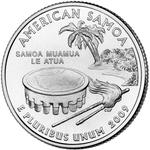The Quarter Dollar is a United States coin worth 25 cents. It has been produced on and off since 1796 and consistently since 1831.
From its inception until 1964, the denomination was issued in silver; it underwent several design changes, including finally the silver Washington quarter (1932 - 1964) featuring the first President of the United States on the obverse and the American Eagle clutching a bunch of arrows on the reverse. Initially meant as a one-year design to commemorate 200 years since the birth of George Washington in 1932, the obverse became the definitive design for the denomination and has been used ever since. The reverse was issued in this form until 1998, after which time the series of State Quarters circulating commemoratives started being issued instead. Between 1999 and 2008, the United States Mint issued five different "state quarters" every year, each dedicated to one of the US states.
After the program ended, the US Mint began issuing quarters under the 2009 District of Columbia and US Territories Program; the six coins are in honour of the District of Columbia and five U.S. territories: the Commonwealth of Puerto Rico, Guam, American Samoa, the U.S. Virgin Islands and the Commonwealth of the Northern Mariana Islands.
The American Samoa quarter is the fourth coin in the DC and U.S. Territories Quarters Program. American Samoa, known as the heart of Polynesia, is a group of five islands and two coral atolls in the South Pacific, approximately 2,300 miles southwest of Hawaii and 2,700 miles northeast of Australia. Contacts with Europeans began in the early 1700s and intensified with the arrival of English missionaries and traders in the 1830s. Under the Treaty of Berlin in 1899, the United Kingdom and Germany gave the United States rights and claims over the area, and it officially became a United States territory in 1929 when Congress ratified deeds of cession dating back to 1900 and 1904.
American Samoa Quarter Dollars issued in 2009 have now been in circulation for 16 years. | 




 Search for United States: Quarter Dollar 2009 American Samoa on eBay
Search for United States: Quarter Dollar 2009 American Samoa on eBay 
